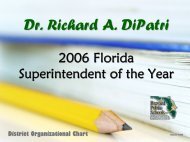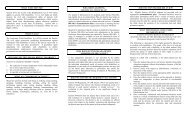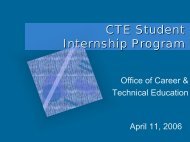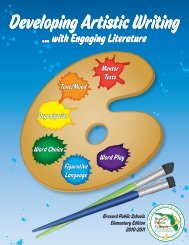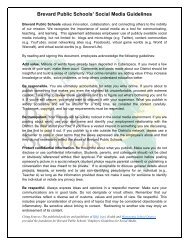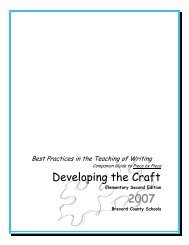by Piece - Brevard Public Schools
by Piece - Brevard Public Schools
by Piece - Brevard Public Schools
Create successful ePaper yourself
Turn your PDF publications into a flip-book with our unique Google optimized e-Paper software.
August thru October<br />
Sixth Grade<br />
Focus: Creative (Narrative), Informative (Expository) p. 41<br />
WRITING APPLICATION/SIX TRAITS SSS RESOURCES<br />
IDEAS:<br />
• Generating ideas from multiple sources(e.g., prior knowledge, discussion,<br />
writer’s notebook, research materials, reliable sources) based upon teacher<br />
directed topics and personal interests<br />
• Develop main ideas using primary and secondary sources appropriate to<br />
purpose and audience and elaborate on ideas<br />
LA.6.3.1.1<br />
LA.6.3.2.1<br />
Definition of narrative DC 31<br />
Definition of expository DC 31<br />
Personal narrative M/MH Unit 1: 127A, 127F; prompt 127B;<br />
Unit 2: Narrative prompt 189<br />
Fictional narrative prompt M/MH Unit 4: 425<br />
ORGANIZATION:<br />
• Make a plan for writing that prioritizes ideas, addresses purpose, audience,<br />
min idea, and logical sequence<br />
• Use organizational strategies and tools(e.g., technology, outline, chart,<br />
table, graph, web, story map)<br />
• Create interesting leads, elaborated middles, and effective endings<br />
• Add transitional words and phrases<br />
• Connect conclusion to ending(e.g., use of the circular ending<br />
• Write in a variety of expressive forms(e.g., short plays, song lyrics, historical<br />
fiction, limericks, )<br />
Creative:<br />
• Beginning, middle, and end (B-M-E), setting, characters, characterization,<br />
plot, rising action, conflict, climax, falling action, and resolution<br />
Informative:<br />
• Write in a variety of informational/Expository forms(e.g., summaries,<br />
procedures, instructions, experiments, rubrics, how-to-manuals, assembly<br />
instructions)<br />
• Write informational/Expository essays(e.g., process, description,<br />
explanation, comparison/contrast, problem/solution) that has a thesis<br />
statement, supporting details, and introductory, body, and concluding<br />
paragraphs<br />
• Write informal and formal communications that follow a formal<br />
• Write directions to unfamiliar locations using cardinal and ordinal directions,<br />
landmarks, and distances, and create an accompanying map<br />
LA.6.3.2.1<br />
LA.6.3.1.3<br />
LA.6.3.3.2<br />
LA.6.4.1.2<br />
LA.6.4.1.1<br />
LA.6.4.2.1<br />
LA.6.4.2.1<br />
LA.6.4.2.3<br />
LA.6.4.2.4<br />
LA.6.4.2.5<br />
Narrative DC 17, Expository DC 5-15<br />
Thinking Maps<br />
Writers workshop M/MH Unit 3: 363A-363F, Narrative<br />
prompt 363B<br />
Interesting lead DC 60<br />
Transition DC 22-26<br />
Literary Devices/Writing Skills, see PbP<br />
Transitions M/MH Unit 1:122A Cause/Effect 123A<br />
Write a scene from a play M/MH Unit 3: 358-359B<br />
Narrative prompts DC 34<br />
Topic sentence/Details M/MH Unit1: 65A<br />
Adding emotions DI 35<br />
Write with a clear beginning, middle, and end M/MH Unit 3:<br />
334-335B<br />
Write a Character Sketch M/MH Unit 3: 272-273B<br />
Time Order Word M/MH Unit 6: 620-621<br />
Write About A Process M/MH Unit 6: 682-683<br />
Diary entry M/MH Unit1:123A<br />
Friendly letter M/MH Unit 1: 65A<br />
See Social Studies (Holt)







